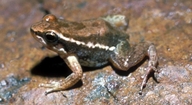|
Hyloxalus insulatus (Duellman, 2004)
| family: Dendrobatidae subfamily: Hyloxalinae genus: Hyloxalus |
| Species Description: Duellman, W. E. (2004)Frogs of the Genus Colostethus (Anura; Dendrobatidae) in the Andes of Northern Peru. �Scientific Papers Natural History Museum University of Kansas, (35), pp 1-49. | |
 © 2004 Natural History Museum and Biodiversity Research Center, The University of Kansas (1 of 6) |
|
|
|
Description The tadpole at Stage 34 has a body length of 13.0 mm and a total length of 38.8 mm. The body is globular, wider than high. The snout is rounded in dorsal view and in profile. The moderately large eyes are situated and directed dorsolaterally and not visible from below. The spiracle is sinistral, short, and attached for its entire length to the body wall; the spiracular opening is directed posterodorsally well below midline at about midlength of the body. The cloacal tube is short, dextral, and attached to the ventral fin. The caudal musculature is robust and about equal in height throughout the proximal half of tail, whereupon it diminishes gradually to a pointed terminus. The dorsal fin originates on the base of the caudal musculature, reaches its greatest height at about midlength of the tail, and diminishes to a bluntly rounded tip; the ventral fin originates on the body wall and reaches its greatest height just posterior to the midlength of the tail. The oral disc is directed anterolaterally. The median half of the anterior labium is bare; elsewhere the labia bear a single row of slender, pointed marginal papillae. The labia are infolded laterally; a few small, round papillae are present in the folds. The jaw sheaths are moderately slender and coarsely serrate; the anterior sheath forms a broad arch, and the lower sheath is broadly V-shaped. The labial tooth row formula is 2(1)/3; A2 is the longest, P3 the shortest, and other rows equal in length. The body is olive brown, and the tail is brown with olive flecks; the iris is pale bronze. Recently metamorphosed young are colored like adults except they are slightly paler and lack dark spots on throat. Distribution and Habitat Country distribution from AmphibiaWeb's database: Peru
Life History, Abundance, Activity, and Special Behaviors
References
Duellman, W. E. (2004). ''Frogs of the genus Colostethus (Anura; Dendrobatidae) in the Andes of northern Peru.'' Scientific Papers of the Natural History Museum, University of Kansas, 35, 1-49. Originally submitted by: William Duellman (first posted 2004-12-13) Edited by: Kellie Whittaker (2007-12-03) Species Account Citation: AmphibiaWeb 2007 Hyloxalus insulatus <https://amphibiaweb.org/species/6358> University of California, Berkeley, CA, USA. Accessed Nov 12, 2024.
Feedback or comments about this page.
Citation: AmphibiaWeb. 2024. <https://amphibiaweb.org> University of California, Berkeley, CA, USA. Accessed 12 Nov 2024. AmphibiaWeb's policy on data use. |


 Map of Life
Map of Life